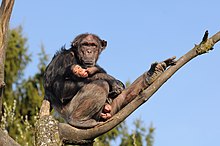| Catarrhines Temporal range:
| |
|---|---|

| |
| Stump-tailed macaques | |

| |
| Chimpanzees (Pan troglodytes) at Walter Zoo, Gossau, St. Gallen, Switzerland | |
| Scientific classification | |
| Domain: | Eukaryota |
| Kingdom: | Animalia |
| Phylum: | Chordata |
| Class: | Mammalia |
| Order: | Primates |
| Suborder: | Haplorhini |
| Infraorder: | Simiiformes |
| Parvorder: | Catarrhini É. Geoffroy, 1812[1][2] |
| Superfamilies | |
| |
| Synonyms | |
The parvorder Catarrhini /kætəˈraɪnaɪ/ (known commonly as catarrhine monkeys, Old World anthropoids, or Old World monkeys) consists of the Cercopithecoidea and apes (Hominoidea). In 1812, Geoffroy grouped those two groups together and established the name Catarrhini, "Old World monkeys", ("singes de l'Ancien Monde" in French).[4][3][5][2][6][excessive citations] Its sister in the infraorder Simiiformes is the parvorder Platyrrhini (New World monkeys).[2] There has been some resistance to directly designate apes (and thus humans) as monkeys despite the scientific evidence, so "Old World monkey" may be taken to mean the Cercopithecoidea or the Catarrhini.[4][7][8][9][10][6][11][12][13][14][excessive citations] That apes are monkeys was already realized by Georges-Louis Leclerc, Comte de Buffon in the 18th century.[3] Linnaeus placed this group in 1758 together with what we now recognise as the tarsiers and the New World monkeys, in a single genus "Simia" (sans Homo).[15] The Catarrhini are all native to Africa and Asia. Members of this parvorder are called catarrhines.
The Catarrhini are the sister group to the New World monkeys, the Platyrrhini.[16][17][18][19] Some six million years before the ape - Cercopithecoidea bifurcation, the Platyrrhini emerged within "monkeys" by migration to South America from Afro-Arabia (the Old World), likely by ocean.
- ^ Cite error: The named reference
msw3was invoked but never defined (see the help page). - ^ a b c d Geoffroy Saint-Hilaire, M.É. (1812). "Tableau des Quadrumanes, ou des animaux composant le premier Ordre de la Classe des Mammifères". Annales du Muséum d'Histoire Naturelle. 19. Paris: 85–122. Archived from the original on 2019-03-27. Retrieved 2019-03-26.
- ^ a b c d Martin, W.C. Linnaeus (1841). A General Introduction to The Natural History Mamminferous Animals, With a Particular View of the Physical History of Man, and the More Closely Allied Genera of the Order Quadrumana, or Monkeys. London: Wright and Co. printers. pp. 339, 340, 361.
- ^ a b Osman Hill, W.C. (1953). Primates Comparative Anatomy and Taxonomy I—Strepsirhini. Edinburgh Univ Pubs Science & Maths, No 3. Edinburgh University Press. p. 53. OCLC 500576914.
- ^ Buffon, Georges Louis Leclerc comte de (1827). Oeuvres complètes de Buffon: avec les descriptions anatomiques de Daubenton, son collaborateur (in French). Verdière et Ladrange. p. 61. Archived from the original on 2023-11-29. Retrieved 2022-04-14.
- ^ a b Bugge, J. (1974). "Chapter 4". Cells Tissues Organs. 87 (Suppl. 62): 32–43. doi:10.1159/000144209. ISSN 1422-6405.
- ^ "Thomas Geissmann's Gibbon Research Lab.: Die Gibbons (Hylobatidae): Eine Einführung". www.gibbons.de. Archived from the original on 2023-03-26. Retrieved 2019-03-15.
- ^ "Reconstruction of Ancient Chromosomes Offers Insight Into Mammalian Evolution". UC Davis. 2017-06-21. Archived from the original on 2023-05-26. Retrieved 2019-03-20.
- ^ Archibald, J. David (2014-07-15). Aristotle's Ladder, Darwin's Tree: The Evolution of Visual Metaphors for Biological Order. Columbia University Press. ISBN 9780231164122. Archived from the original on 2023-11-29. Retrieved 2020-11-09.
- ^ Lacoste, Vincent; Lavergne, Anne; Ruiz-García, Manuel; Pouliquen, Jean-François; Donato, Damien; James, Samantha (2018-09-15). "DNA Polymerase Sequences of New World Monkey Cytomegaloviruses: Another Molecular Marker with Which To Infer Platyrrhini Systematics". Journal of Virology. 92 (18): e00980–18. doi:10.1128/JVI.00980-18. ISSN 0022-538X. PMC 6146696. PMID 29976674.
- ^ James, Samantha; Donato, Damien; Pouliquen, Jean-François; Ruiz-García, Manuel; Lavergne, Anne; Lacoste, Vincent (2018-07-05). "DNA Polymerase Sequences of New World Monkey Cytomegaloviruses: Another Molecular Marker with Which To Infer Platyrrhini Systematics". Journal of Virology. 92 (18). doi:10.1128/JVI.00980-18. PMC 6146696. PMID 29976674.
- ^ Marc Luetjens, C.; Weinbauer, Gerhard F.; Wistuba, Joachim (2007-03-15). "Primate spermatogenesis: new insights into comparative testicular organisation, spermatogenic efficiency and endocrine control". Biological Reviews. 80 (3): 475–488. doi:10.1017/S1464793105006755. ISSN 1464-7931. PMID 16094809. S2CID 21241457. Archived from the original on 2023-11-29. Retrieved 2022-01-02.
- ^ Osorio, Daniel (2021-08-19). Simmons, Leigh (ed.). "What is primate color vision for? a comment on Caro et al". Behavioral Ecology. 32 (4): 571–572. doi:10.1093/beheco/arab050. ISSN 1045-2249. Archived from the original on 2022-03-07. Retrieved 2022-03-07.
- ^ Nakamura, Tomonori; Fujiwara, Kohei; Saitou, Mitinori; Tsukiyama, Tomoyuki (2021-05-11). "Non-human primates as a model for human development". Stem Cell Reports. 16 (5): 1093–1103. doi:10.1016/j.stemcr.2021.03.021. ISSN 2213-6711. PMC 8185448. PMID 33979596.
- ^ Linné, Carl von; Salvius, Lars (1758). Caroli Linnaei...Systema naturae per regna tria naturae :secundum classes, ordines, genera, species, cum characteribus, differentiis, synonymis, locis. Vol. 1. Holmiae: Impensis Direct. Laurentii Salvii. Archived from the original on 2017-03-25. Retrieved 2022-04-28.
- ^ Garbino, Guilherme Siniciato Terra; De Aquino, Carla Cristina (2018). "Evolutionary Significance of the Entepicondylar Foramen of the Humerus in New World Monkeys (Platyrrhini)". Journal of Mammalian Evolution. 25: 141–151. doi:10.1007/s10914-016-9366-5. S2CID 3268953.
- ^ Fulwood, Ethan L.; Boyer, Doug M.; Kay, Richard F. (2016). "Stem members of Platyrrhini are distinct from catarrhines in at least one derived cranial feature". Journal of Human Evolution. 100: 16–24. doi:10.1016/j.jhevol.2016.08.001. PMID 27765146.
- ^ Dixson, Alan (2015). "Primate sexuality". The International Encyclopedia of Human Sexuality. pp. 861–1042. doi:10.1002/9781118896877.wbiehs375. ISBN 9781118896877.
- ^ Takai, Masanaru; Maung-Maung; Sein, Chit; Soe, Aung Naing; Thaung-Htike; Zin-Maung-Maung-Thein (2017-01-01). "Chapter 9 Review of the investigation of primate fossils in Myanmar". Geological Society, London, Memoirs. 48 (1): 185–206. doi:10.1144/M48.9. ISSN 0435-4052. S2CID 90910477.